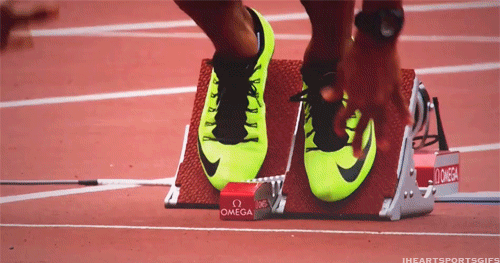The Relay Handoff
You know it. CoachUp knows it. The World knows it — but, simply put, the relays are some of the most exciting events during any given track and field meet. Crowds are always extremely enthusiastic to view the 4×100, 4×200, 4×400, and 4×800, especially when competitors are close during that last, crucial leg. While track and field can be considered mostly an individual sport, the relays must have a succinct team effort in order to succeed.
When seconds are so vital, it’s essential to pass the baton to the next runner as seamlessly and as efficiently as possible. High stakes mean that a poorly executed exchange can cost a team the race and, in some circumstances, an entire meet.There are multiple types of handoffs, since different distances require different strategies — so grab CoachUp’s quick and easy guide and start nailing this difficult motion.

Non-Visual Exchanges
Non-visual exchanges are commonly used for shorter relays in which the runners are handing off the baton at higher speeds, like the 4x100m relay. This type of exchange means that the receiving runner does not see the baton as it is placed into his or her hand. In addition, the runner must not turn and look back to receive the baton. The pair of runners must match speeds as closely as possible as the handoff occurs, so timing is key. This requirement can be challenging for the outgoing runner as the athlete must sync their acceleration with the incoming runner’s top speed. There are three types of non-visual exchanges — the upsweep, downsweep, and push, so make sure you’re comfortable with them all!
The Upsweep
The upsweep, in loads of ways, is a type of blind pass. An outgoing runner’s hand is held behind them at waist height with the palm facing down. This is a more natural position for the receiver — as opposed to putting the hand behind the back and then twisting it palm up. Then, the incoming runner swings the baton up into the receiver’s hand, placing it between the thumb and fingers
The Downsweep
Next, you’ve got the downsweep and now the runner will flip their palm upwards to receive the baton. Here, the outgoing runner’s thumb should be turned towards the torso, creating a v-shape and a nice pocket to pass into. The incoming runner comes down to place the baton in the receiver’s hand, who reaches back to grip the upper third of the baton.
As we mentioned before, the downsweep is a little more uncomfortable, but does provide a security blanket for both athletes. It can be difficult to receive a pass from ground up because any errant handoff will be immediately pulled down by gravity. Thus, with the palm facing up, there’s a bigger target area for both runners to use and the ability to corral any less-than-perfect handoff because the palm will act as a safety net.
The Push
During a push pass, the receiver’s hand is extended parallel to the ground with the thumb facing directly down. The incoming runner pushes the baton vertically into the receiver’s hand. Since these passes are blind, sometimes runners rely on verbal cues to coordinate their pass. Try yelling something easy to understand like stick or hand to signify when the outgoing runner should reach out their hand and prepare to receive the baton.
Visual Exchanges
Visual exchanges rely on a cue to understand when and where the baton will be passed and involve the outgoing runner looking back for help. This type of handoff is frequently used in relays of longer distances because the runners is not required to be at top speed by the time he receives the baton. The most effective starting position for the outgoing runner is the crouch start. In this position, the runner should face forward, one leg in front of the other. Then, the left hand should be extended out and the incoming runner should keep running at full speed as they place the baton into the outstretched hand. Of course, it’s the responsibility of the runner to switch the baton from the left to the right hand during his or her leg.
(Related: Read about becoming a better discus thrower here.)
Huddle Up
For any team that wants to execute a relay at the fastest speed possible, it’s essential to master the relay pass. Although a team can never know how the race will pan out, hours of repetitions and run-throughs are a good way to be as prepared as possible. And, as we mentioned before, all it takes is one poor handoff and a dropped baton to shatter first place hopes.
If you’re not getting enough individual attention at practice or don’t have a partner to run through these various methods, consider booking one of CoachUp’s private trainers to work with you. Whether you need tips on hand placement and transitioning or just need somebody to run reps with, we can can help! Our talented team will have you nailing the small details of the handoffs so you can stay focused on hitting your fastest speeds on the track. What are you waiting for?
How useful was this post?
Click on a star to rate it!
Average rating 4.1 / 5. Vote count: 23
No votes so far! Be the first to rate this post.




One Response
This site is very useful and has a lot of information in a very simple form. I like it!
Keep the work up and continue with the simple information but also very useful.